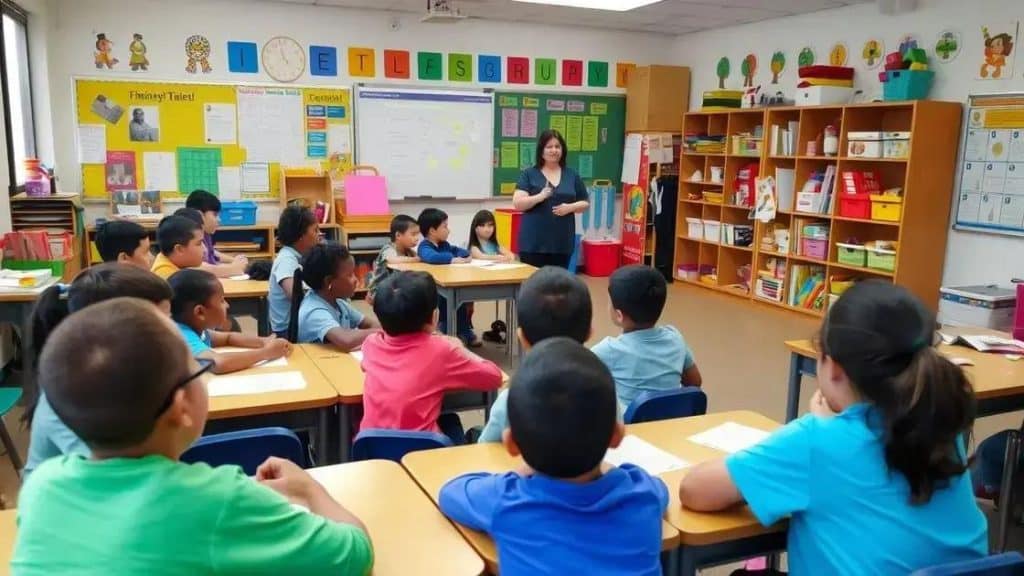Ready education budget increase: how it can transform schools

An increase in the education budget enhances resources, improves school infrastructure, and integrates technology, leading to better student performance and educational outcomes.
Ready education budget increase is crucial for revamping our schools and empowering students. Have you thought about what more funding could achieve for your community’s education? Let’s explore the potential benefits together.
Understanding the current education budget landscape
Understanding the current education budget landscape is essential for grasping how funding impacts schools. Today, schools face various challenges that affect their ability to offer quality education. A robust education budget can empower schools to address these issues more effectively.
Current Funding Sources
Funding for education primarily comes from three sources: federal, state, and local governments. Each source plays a vital role in shaping the education budget. It’s important to recognize how these funds are allocated across different districts.
- Federal funding usually supports programs for low-income students.
- State funding is often based on enrollment numbers.
- Local funding typically relies on property taxes, which can vary widely.
Factors such as local property values can greatly influence budget size, leading to disparities in what schools can offer. A school in a wealthier area may have more resources compared to one in a less affluent community. These inequalities raise questions about fairness and access to quality education.
Challenges in Budget Allocation
Many districts struggle with budget constraints that hinder their ability to meet educational needs. The impact of these challenges is felt in various ways. For instance, limited funding often results in overcrowded classrooms and outdated materials.
- Overcrowded classrooms can reduce individual attention.
- Outdated textbooks may hinder effective learning.
- Technology gaps can limit educational innovation.
Moreover, unexpected expenses, such as maintenance costs or emergency repairs, can further strain budgets. This creates a cycle where schools can’t invest in essential resources, ultimately affecting student outcomes.
As we delve deeper into the budget landscape, it’s crucial to consider how these dynamics can be transformed. Increased funding could address the disparities and enhance educational experiences for all students.
Impact of increased funding on school infrastructure
The impact of increased funding on school infrastructure is significant. As schools receive more financial support, they can invest in essential upgrades that enhance learning environments. This improvement directly influences student experience and academic success.
Benefits of Improved Infrastructure
With increased funding, schools can make vital changes. These benefits include better facilities and updated technology that can enrich the learning process.
- Renovated classrooms create better learning environments.
- State-of-the-art technology supports innovative teaching methods.
- Enhanced libraries and labs provide valuable resources for students.
Moreover, safe and engaging school buildings foster a positive atmosphere. When students feel comfortable and supported, they are more likely to participate actively in their education.
Addressing Maintenance Issues
In many districts, aging infrastructure is a pressing problem. Increased funding allows schools to fix existing issues rather than merely making temporary repairs.
- Repairing leaky roofs can prevent further damage.
- Upgrading heating and cooling systems ensures a comfortable learning environment.
- Improving restrooms and common areas promotes student health and well-being.
Consistent maintenance prevents costly emergency repairs down the road. This proactive approach sets a foundation for long-term success and sustainability.
As funding increases, the opportunity for schools to enhance both the physical and emotional learning environments becomes a reality. Ultimately, these changes contribute to better educational outcomes and a brighter future for students.
How budget increases can enhance teacher resources

How budget increases can enhance teacher resources is a crucial topic for improving education. When schools receive additional funds, they can provide teachers with the tools and support they need to excel.
Access to Quality Materials
With more resources, teachers can obtain high-quality teaching materials. This includes textbooks, software, and other educational tools that can improve lesson delivery.
- Updated textbooks provide accurate information.
- Engaging digital resources can enhance learning experiences.
- Hands-on materials support diverse learning styles.
When teachers have access to these materials, they can create engaging lessons that inspire students. This fosters a love for learning and encourages student success.
Professional Development Opportunities
Increased funding also allows schools to invest in professional development for teachers. Ongoing training is essential to keep educators current with teaching methods and technologies.
- Workshops can introduce innovative teaching strategies.
- Collaboration with other educators can lead to shared best practices.
- Access to conferences helps teachers network and learn.
When teachers improve their skills, students benefit from more effective instruction. This directly contributes to a better learning environment for all.
Moreover, well-resourced teachers can focus more on individualized learning. When necessary supplies and support are available, they can better meet the diverse needs of their students. Ultimately, increasing the budget leads to a more effective educational experience for everyone involved.
The role of technology in funded educational initiatives
The role of technology in funded educational initiatives cannot be overstated. When schools have the financial support to invest in technology, they can significantly enhance the learning experience for students.
Incorporating Digital Tools
With increased funding, schools can incorporate various digital tools into their curriculums. These tools can facilitate a more interactive and engaging learning environment.
- Smartboards enable dynamic presentations and collaboration.
- Learning management systems streamline communication between students and teachers.
- Educational software provides personalized learning experiences.
As technology becomes more integrated into classrooms, students often show improved motivation and engagement. These tools can transform traditional teaching methods, making lessons more vibrant and relevant.
Access to Online Resources
Moreover, access to online educational resources is another vital aspect of technology in education. Funded initiatives can provide students with the ability to explore vast amounts of information and materials at their fingertips.
- Students can access digital libraries filled with e-books and research articles.
- Online courses offer additional learning opportunities outside the classroom.
- Virtual labs allow students to conduct experiments safely and effectively.
These resources expand learning beyond the limitations of physical textbooks and classrooms. Students can learn at their own pace and revisit materials as needed, fostering a deeper understanding of the subject matter. As schools increasingly focus on integrating technology, they build stronger connections between students and the skills they will need in the future.
Evaluating the long-term effects on student performance
Evaluating the long-term effects on student performance is essential in understanding the impact of educational funding. As schools receive more resources, it is crucial to measure how these changes influence student outcomes over time.
Data Collection and Analysis
To evaluate these effects, schools need to gather and analyze various types of data. Tracking student performance can provide insights into how increased funding correlates with academic success.
- Standardized test scores can offer measurable benchmarks.
- Graduation rates show the overall effectiveness of educational programs.
- Longitudinal studies help track progress over multiple years.
By looking at this data, educators can determine if funding leads to improvements in key areas. Identifying trends helps schools understand what strategies work best and where adjustments are needed.
Influence on Engagement and Retention
More funding often leads to improved engagement among students. When schools can enhance their programs, students are more likely to stay interested and invested in their education. This engagement can lead to higher retention rates and ultimately better performance.
- Interactive learning environments keep students motivated.
- Availability of extracurricular activities offers diverse experiences.
- Smaller class sizes allow for personalized attention.
As students feel more connected and supported, they tend to perform better academically. The goal is to create an education system that nurtures and inspires students to reach their full potential.
Evaluating these long-term effects helps educators make informed decisions about resource allocation and program development. By focusing on continuous improvement, schools can foster an environment where all students thrive.
FAQ – Frequently Asked Questions about Education Budget Increases
How does increasing the education budget benefit students?
Increasing the education budget allows schools to provide better resources, improved infrastructure, and access to technology, leading to enhanced learning experiences for students.
What role does technology play in funded educational initiatives?
Technology enhances student engagement and learning by providing access to digital tools and online resources, making education more interactive and effective.
How can we evaluate the impact of budget increases on student performance?
We can evaluate the impact by tracking metrics such as standardized test scores, graduation rates, and student engagement levels over time to see improvements.
Why is it important to support teacher resources with increased funding?
Supporting teacher resources improves lesson quality and professional development, which directly affects student learning outcomes and overall educational success.





